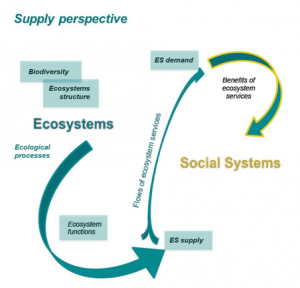An AQUACROSS report on causal flow indicators between biodiversity, ecosystem functions, and ecosystem services in the aquatic environment is available online. An executive summary and annex providing indicators of biodiversity, ecosystem functions, and ecosystem services in the aquatic environment is also available.
Central to AQUACROSS is understanding the socio-ecological system and how society both affects and depends on aquatic ecosystems. Ecosystem based management aims to holistically manage ecosystems, which includes understanding how biodiversity or loss thereof affects the functioning of an ecosystem and therefore its ability to provide ecosystem services.
The report “Assessment of causal flows between biodiversity, ecosystem functions and ecosystem services in aquatic environments,” examines the ‘supply side’ or determinates of provisionary capacities (biodiversity, ecosystem functions and services) of ecosystems (see Figure). The aim of the report is to establish a common baseline for identifying and analysing the factors influencing aquatic biodiversity loss, how these factors interact, and what are the management options available to ensure robust and healthy aquatic ecosystems, capable of providing ecosystem services. Led by UAVR, authors of the report conducted a literature review of scientific publications on the interaction between biodiversity, ecosystem functions, and ecosystem services.
The report is supplementary to the AQUACROSS Assessment Framework, which provides a common framework for assessing complex systems and developing management plans that reflect the complexity, interdependencies, and uncertainty of socio-ecological ecosystems. It identifies the main challenges for operationalising the AQUACROSS Assessment Framework and provides an overview of the supporting information and resources available at specific stages of the supply-side. In addition, by identifying the main links of the ecological system with the socio-economic system, it promotes a fully integrated assessment. It should be read in parallel with the AQUACROSS report ‘Drivers of change and pressures on aquatic ecosystems,’ which sets out to offer a common, trans-disciplinary understanding of societal drivers, human activities, and pressures that affect aquatic ecosystems and biodiversity.
The end goal is to support integrated ecological assessments that account for socio-economic feedbacks with nature; by establishing flow linkages both upstream, to pressures affecting the ecosystems, and downstream, to the demand of ecosystem services. This report and associated outputs will support work being conducted in the AQUACROSS case studies by offering practical guidance on how to identify and analyse biodiversity, ecosystem functioning, and ecosystem services classification schemes and associated indicators, and a set of modelling approaches for establishing the biodiversity, ecosystem functioning, and ecosystem services and causal links.
Lessons learnt in AQUACROSS regarding the causal links between biodiversity, ecosystem functions and ecosystem services, and regarding best approaches for their assessment, will ultimately provide inputs and feedback into environmental policies acting in the field of aquatic ecosystems, towards adaptation and a better implementation of these legal requirements in practical management scenarios.
The full report and executive summary are available online.


